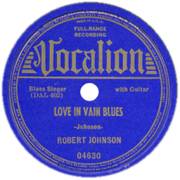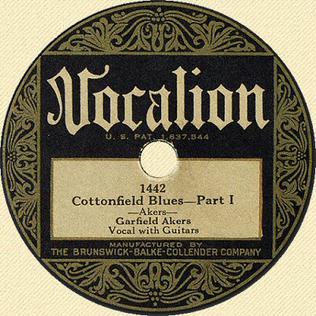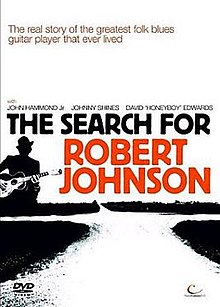
Robert Leroy Johnson was an American blues musician and songwriter. His singing, guitar playing and songwriting on his landmark 1936 and 1937 recordings has influenced later generations of musicians. Although his recording career spanned only seven months, he is recognized as a master of the blues, particularly the Delta blues style, and as one of the most influential musicians of the 20th century. The Rock and Roll Hall of Fame describes him as perhaps "the first ever rock star".

Robert Lockwood Jr., a.k.a. Robert Jr. Lockwood, was an American Delta blues guitarist, who recorded for Chess Records and other Chicago labels in the 1950s and 1960s. He was the only guitarist to have learned to play directly from Robert Johnson. Robert Lockwood was one of the first professional black entertainers to appear on radio in the South, on the King Biscuit Time radio show. Lockwood is known for his longtime collaboration with Sonny Boy Williamson II and for his work in the mid-1950s with Little Walter.

John Ned Shines was an American blues singer and guitarist.

Charlie Patton, more often spelled Charley Patton, was an American Delta blues musician and songwriter. Considered by many to be the "Father of the Delta Blues", he created an enduring body of American music and inspired most Delta blues musicians. The musicologist Robert Palmer considered him one of the most important American musicians of the twentieth century.

David "Honeyboy" Edwards was an American delta blues guitarist and singer from Mississippi.

Willie Lee Brown was an American blues guitar player and vocalist. He performed and recorded with other blues musicians, including Son House and Charlie Patton, and influenced Robert Johnson and Muddy Waters. Brown is considered one of the pioneering musicians of the Delta blues genre.

Joe Willie "Pinetop" Perkins was an American blues pianist. He played with some of the most influential blues and rock-and-roll performers of his time and received numerous honors, including a Grammy Lifetime Achievement Award and induction into the Blues Hall of Fame.

"Love in Vain" is a blues song written by American musician Robert Johnson. Johnson's performance – vocal accompanied by his finger-style acoustic guitar playing – has been described as "devastatingly bleak". He recorded the song in 1937 during his last recording session and in 1939 it was issued as the last of his original 78 rpm records.

Ishmon Bracey, sometimes credited as Ishman Bracey, was an American Delta blues singer-guitarist. Alongside his contemporary Tommy Johnson, Bracey was a highly influential bluesman in Jackson, Mississippi, and was one of the area's earliest figures to record blues material. Bracey's recordings include "Trouble Hearted Blues" and "Left Alone Blues", both of which appear on several compilation albums.

"Cross Road Blues" is a song written by the American blues artist Robert Johnson. He performed it solo with his vocal and acoustic slide guitar in the Delta blues style. The song has become part of the Robert Johnson mythology as referring to the place where he sold his soul to the Devil in exchange for musical genius. This is based largely on folklore of the American South that identifies a crossroads as the site where Faustian bargains can be made, as the lyrics do not contain any references to Satan.
Henry Columbus Speir was an American "talent broker" and record store owner from Jackson, Mississippi. He was responsible for launching the recording careers of most of the greatest Mississippi blues musicians in the 1920s and 1930s. According to blues researcher Gayle Dean Wardlow, "Speir was the godfather of Delta Blues" and was "a musical visionary [without whom] Mississippi's greatest natural resource might have gone untapped." A historical marker commemorates his life and work.
A guitar battle is where two or more guitar players take turns soloing, either with or without a rhythm section. The purpose of the guitar battle is to determine who among each of the guitar players present is the most proficient on the instrument. Often, it begins with the guitarists trading licks and phrases, while gradually increasing the complexity of the technique used. A guitar battle can be said to be over when one guitarist outplays all the other guitar players present. This is also known among guitarists as a head-cutting duel or simply as cutting heads.

"Stop Breaking Down" or "Stop Breakin' Down Blues" is a Delta blues song recorded by Robert Johnson in 1937. An "upbeat boogie with a strong chorus line", the lyrics are partly based on Johnson's experience with certain women:

"Dust My Broom" is a blues song originally recorded as "I Believe I'll Dust My Broom" by American blues artist Robert Johnson in 1936. It is a solo performance in the Delta blues-style with Johnson's vocal accompanied by his acoustic guitar. As with many of his songs, it is based on earlier blues songs, the earliest of which has been identified as "I Believe I'll Make a Change", recorded by the Sparks brothers as "Pinetop and Lindberg" in 1932. Johnson's guitar work features an early use of a boogie rhythm pattern, which is seen as a major innovation, as well as a repeating triplets figure.
Gayle Dean Wardlow is an American historian of the blues. He is particularly associated with research into the lives of the musicians Charlie Patton and Robert Johnson and the historical development of the Delta blues, on which he is a leading authority.

Garfield Akers was an American blues singer and guitarist. He had sometimes performed under the pseudonym "Garfield Partee". Information about him is uncertain, and knowledge of his life is based almost entirely on reports of a few contemporary witnesses.
Mississippi Delta bluesman Robert Leroy Johnson has been called the "King of the Delta Blues Singers", the "Grandfather of Rock and Roll" and "the most important blues singer that ever lived". The guitars he played, recorded and was photographed with have always been of interest to blues researchers and musicologists, and this interest eventually led to the production of guitars dedicated to his memory.
Henry "Son" Sims was an American Delta blues fiddler and songwriter. He is best known as an accompanist for Charley Patton and the young Muddy Waters.

American blues musician Robert Johnson (1911–1938) recorded 29 songs during his brief career. A total of 59 performances, including alternate takes, were recorded over a period of five days at two makeshift recording studios in Texas. Producers selected 25, which Vocalion Records issued on 12 two-sided 78 rpm record singles between 1937 and 1939. These went out-of-print, but were the only source of Johnson's work until his recordings were eventually issued on albums beginning in 1959. In addition to those on the original singles, another 17 recordings have been released.














